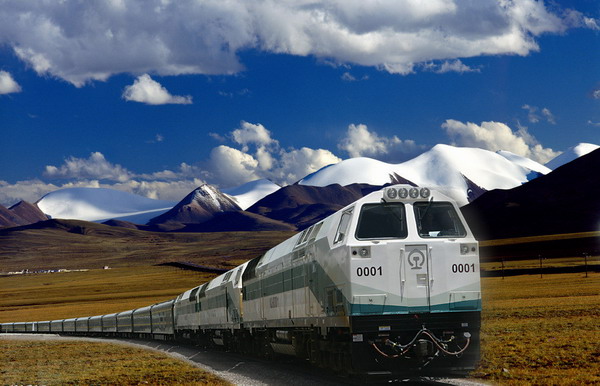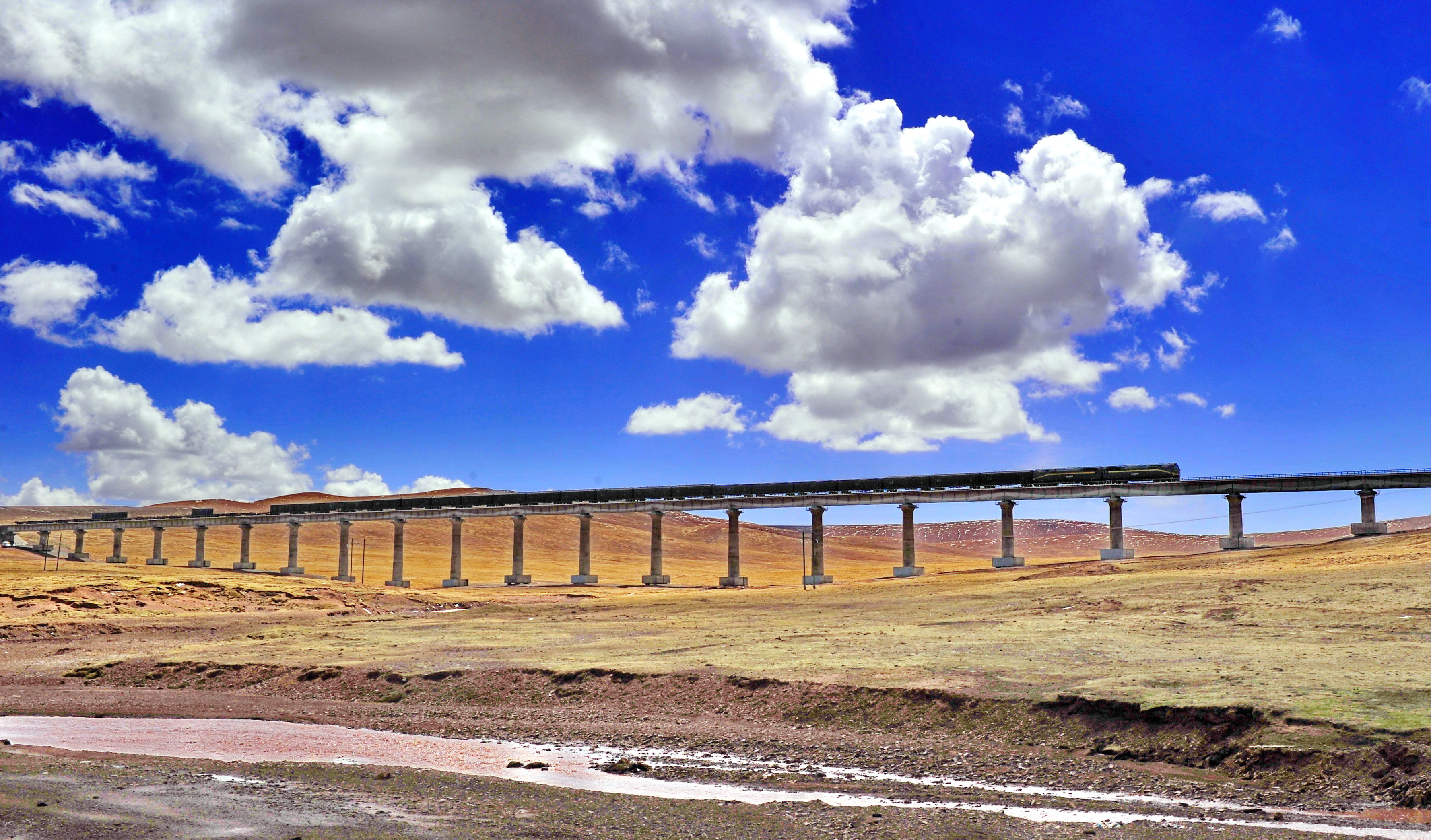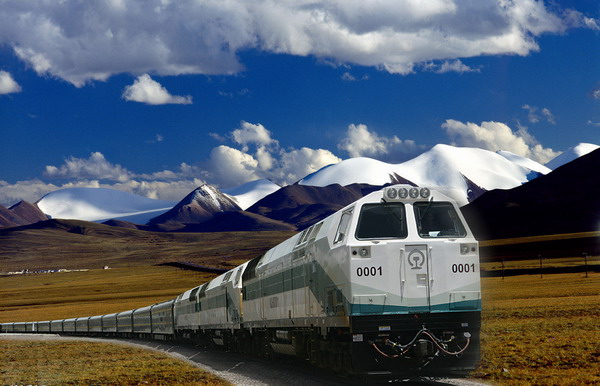Special report: 10 year anniversary of the Qinghai-Tibet Railway

The 20th century American travel writer Paul Theroux wrote in his book Sailing Through China that as long as there’s the Kunlun Mountains, the train could never reach Lhasa. Today, the Qinghai-Tibet Railway has been built for 10 years.
Dreams of many generations
The Qinghai-Tibet Railway starts from Xining and ends at Lhasa. At a distance of 1956 km, it’s the worlds’ longest railway that’s built on a plateau, at the highest-altitude, and with the longest penetration through frozen soil. Soon after the new China was established, national agencies began exploring the possibility of building a railway into Tibet.
In 1958, phase 1 of the Qinghai-Tibet Railway, from Xining to Golmud, began construction, and was completed in 1984. Limited by the economic power at the time, and the technical challenges of the plateau and frozen soil, the Golmud–Lhasa portion of the railway was forced to stop.
In July of 1994, the Party Central Committee held its third National Conference on Work in Tibet. The Ministry of Railways proposed multiple plans for constructing railways to Tibet, and recommended building the Qinghai-Tibet Railway.
In February of 2001, the Party Central Committee and the State Council approved phase 2 of the Qinghai-Tibet Railway, starting work on the Golmud–Lhasa portion. This part of the railway is 1142 km in length and has 960 km at altitudes higher than 4000 meters, with the highest point at 5072 meters. The railway had to go through 550 km of frozen soil, which was untouched for decades; it is the most challenging construction project in the history of railway construction.
In June of 2001, the Golmud–Lhasa portion began construction on the Qinghai-Tibet Railway.
On July 1st, 2006, the Qinghai-Tibet Railway was completed and the railway began operation.
The Qinghai-Tibet Railway and the Tibet's economy
After the railway began operation, tourism in Tibet enjoyed explosive growth. The number of tourists grew from 1.8 million in 2005 to 20 million in 2015; tourism income surged from 1.94 billion yuan to 28 billion yuan. Tibet’s GDP increased from 34.2 billion yuan in 2006 to 102.6 billion yuan in 2015. As of June 2016, there have been 115 million passengers and 448 million tons of freight transported on the railway. The unique agricultural products and ethnic crafts from the Tibetan Plateau were able to reach a much broader audience thanks to the railway.
The Qinghai-Tibet Railway and transportation in Tibet
After the railway launched, Tibet’s old limited mode of transportation was transformed, expanding its travel options, forming a multi-dimensional transportation framework with rail, road, and air, creating a foundation for building the social economy in Tibet. As of the end of 2015, there have been 17.39 million passengers and 26.05 million tons of freight moved through the Lhasa Railway Station, with the annual growth at 21% and 40% respectively. There have been 8.78 million passengers and 22.29 million tons of freight entering Tibet, and 8.61 million passengers and 3.77 million tons of freight moving out of Tibet.
The Qinghai-Tibet Railway and the standard of living in Tibet
In the past 10 years, the standard of living in Tibet has improved tremendously. The railway has improved the education, work, and medical care options of Tibetans traveling out of Tibet, and made worshipers’ pilgrimage into Tibet easier. The railway has helped reduce the price of all goods, adding variety to all products. One can now find anything in Lhasa that an inland Chinese city offers. Data from the railway and the Tibetan economy showed that the GDP in Tibet grew from 34.2 billion yuan in 2006 to 102.6 billion yuan in 2015, with annual GDP growth surpassing 10%. The railway played a pivotal role in this achievement.
Scenic stops on the Golmud–Lhasa portion of the Qinghai-Tibet Railway
There are 34 stops on the Golmud–Lhasa portion of the Qinghai-Tibet Railway, with scenic outlook areas at the following stations: Yuzhu Peak Station, Chuma'er River Station, Tuotuo River Station, Buqiangge Station, Tanggula Station (entering Tibet), Tsonag Lake Station, Nagqu Station, Damxung Station, and Yangbajing Station.
Your Comment
Name E-mailRelated News
-
;
-
-

-
Travel with belief: Muslims fast on Qinghai-Tibet Railway
Photo shows Ma Shemu (first left )waits for the night when the day's fast is broken, on train Z917 from Lanzhou to Lhasa, June.21.
-
-
-

-
Qinghai-Tibet Railway has become engine for economy in 10 years
Over the past ten years, the Qinghai-Tibet Railway has become the economy engine for "roof of the world".
-
-
-

-
Renovation work starts on the Qinghai-Tibet railway
Expansion and renovation of the Golmud-Lhasa section of the Qinghai-Tibet railway is already in full swing.
-
Based in Lhasa, Tibet Vista is a Tibet travel agency that specialized in Tibet permit, and Tibet tours for both private and group travelers at a local price!
•4 Days Lhasa City Group Tour from USD 460 •8 Days Everest Base Camp Group Tour from USD 850 •15 Days Mt.Kailash Group Tour from USD 1780 •2016 Tibet Train Tours from Beijing, Shanghai, Chengdu, Xining,etc










